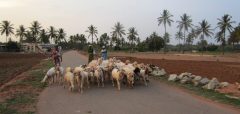Farming though predominant, was only one among the many mutually reliant rural professions. Rurality used to be reflected in unique skills and artistry. Farmers, weavers, carpenters, blacksmiths, barbers, musicians etc closely interacted and formed the rural society. Though marred with caste disparity, this skill rich society meant local self-reliance. Such diversity is fast disappearing, with farming as the only rural character, albeit in a vulnerable state. Despite surrendering to the mainstream market economy, the woes of both farmers and non-farmers remain unabated. Was deskilling the rural society a necessary cost towards socio-economic change?
Yankappa belongs to a family of musicians near Yadgir. He is a seasoned tabla player like his father and forefathers. Though he loves to play percussion instruments, that cannot earn him a livelihood anymore. He accuses television for shifting people’s time and taste away from local events with folk songs. Last year, Yankappa earned a paltry 20,000, playing tabla.

Though not too comfortable to take up farming as their major occupation, this family of five tries to cultivate cotton in three acres of dry land -including one acre of leased land- and also engage in wage labour. While three acres of input intensive cotton farming earned him 1.03 lakhs, its’ expenses crossed 1.5 lakhs. Wage income of about 60,000 helped the family survive. Yankappa sounded desperate talking about his unpaid loan of 1.3 lakhs taken from other villagers and the co-operative bank as well as the 30 grams of gold that they lost to a money lender.
Puttaswamy and his wife belong to the community of nekars (weavers). Their village in North East Karnataka is known for skillful nekars. All 200 households in the village used to be involved in weaving. But they could not compete with machine made cheaper cloth. Now there are only 50-60 families of weavers, mostly contracted by Khadi Gram Udyog (KGU) in Kodekal. Most moved to other occupations though working as agricultural wage labour or construction labour was too strange for many among them.
Puttaswamy and his wife still engage in weaving, taking orders for two-three sarees every month from local women. His wife mostly works on charaka while he does all other things required. For the past 5-6 years, they both have started working as handloom weavers with KGU in Kodekal. All materials and equipments are provided by KGU and even lends them small amount of money in crisis. They can avail credit from KGU in exchange of work.

Puttaswamy also diversified. He has a petty shop selling small daily need things and also leases out an acre of their dry land. His share of red gram from the rainfed leased land is usually just enough to be used at home. That year (2015) they earned 11,600 from selling red gram, about 14,400 from weaving, and 18,000 from the petty shop. Thus even in a good agricultural year, this two member household finds it difficult to repay the loan of half a lakh taken to repair their house and also to meet cultivation expenses. Yet, Puttaswamy feels he is respected for his weaving skills and would rather stay back in the village as long as the basket of livelihood options – weaving, leasing farm land and the petty shop – helps them survive.
